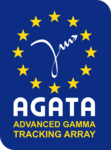In this work, we studied the structure of the pf-shell N=Z nucleus $^{52}$Fe with relativistic radioactive ion beam techniques to reveal the collectivity in this region. $^{52}$Fe presents an interesting case in which we see the onset of a collective structure that is more common nuclear property in heavier nuclei. We deduced the reduced transition probability of the 0$_{gs}^{+}$ $\rightarrow$...
In order to shed light on the open question of the seniority conservation in the proton g9/2 orbital in the N=50 isotones [1,2], reduced transition probabilities in 90Zr, 92Mo and 94Ru nuclei, have been determined experimentally for the first time via lifetime measurements at the GANIL laboratory. The unconventional use of multi-nucleon transfer reaction [3] with a differential plunger device...
Some years ago, unnatural-parity doublet states in 212Po with spins of 4-, 6-, and 8-, which were observed to decay via strong E1 transitions to the yrast band in an experiment performed with the EUROBALL spectrometer, were interpreted as being of alpha-cluster structure. Subsequent theoretical work seemed to support this interpretation. The aim of experiment E693 was to study the...
Nuclei around N=60, Z=40 show a rapid variation in the deformation of their ground state with a rather small change in the neutron number. This feature manifests a subtle interplay between different aspects of the forces in the nucleus and makes this region an ideal testing ground for various nuclear structure theories. As an example, it is established that the ground state of Zr isotopes vary...
The goal of Experiment E706 was to measure lifetimes of excited states in neutron-rich fission fragments in the mass A≈110 region. A beam of 238U was incident on a 9Be target, which was mounted in the OUPS plunger device together with a Mg degrader foil. The fission fragments were identified in mass and atomic number in the VAMOS++ spectrometer, while γ rays were detected with the AGATA and...
Light neutron-rich nuclei, such as C and N isotopes, are a fertile ground for nuclear structure and nuclear astrophysics studies. Several nuclei in this region were populated in an experiment realised in GANIL, employing the deep-inelastic reaction $^{18}$O (7.0 MeV/A) + $^{181}$Ta and studied exploiting the state-of-the-art AGATA gamma-tracking array, coupled to the PARIS scintillation array...
This was the first experiment with NEDA and the full setup, and it suffered of some issues.
The (alpha+n) channel 63Ge has been searched carefully, so far without success. Many contaminating channels contribute to the background. In particular, we have found contaminant channels from the reaction induced by 40Ar, present in the beam producing residues with larger cross sections for...
The E703 experiment was performed at GANIL in April–May 2018, with the setup of AGATA-NEDA-DIAMANT. This measurement aimed at the observation of gamma rays emitted from excited states of the nuclei 102Sn and 103Sn, from which two-body neutron interactions, single-particle energies and N=Z=50 core excitations could be inferred. The data analysis is pursued in Warsaw, Stockholm and Uppsala.
In...
The study of the nuclear deformation for nuclei between $^{40}$Ca and $^{56}$Ni, characterized by the $f_{7/2}$ proton and neutron shell, has historically played a fundamental role in developing the understanding of nuclear structure. In this mass region, the mirror pair $^{49}$Cr and $^{49}$Mn were well-studied through Mirror Energy Differences but the information on the evolution of...
Shell evolution of neutron-deficient Xe isotopes:
Quadrupole and Octupole Collectivity above 100Sn
Status of the Analysis of the Experiment E730 performed with the
AGATA-NEDA-DIAMANT-OUPS set-up
M.L. Jurado-Gómez, IFIC, Spain E.Clément, GANIL, France, A.Gadea, IFIC, Spain J.J. Valiente-Dobón, INFN-LNL, Legnaro, Italy.
The region that lies just above the Z=50 closed shell in the...
Two recent measurements performed at GANIL studied the unbound nucleus $^{15}$F using a SPIRAL 1 radioactive $^{14}$O beam impinging on the hydrogen nuclei from a thick (100 $\mu$m) polyethylene (CH$_2$) target. The first experiment was performed using the MUST2 light-particle detector array at LISE. The second experiment was part of the campaign using the new MUGAST light particle detector...
We present new experimental results for a measurement utilising the combination of AGATA, MUGAST, and VAMOS for a determination of the astrophysical $^{15}$O alpha capture reaction rate [1]. This reaction is a key breakout route from the Hot CNO cycle leading to explosive nucleosynthesis via the rp-process on the surface of neutron stars in binary systems. Determining an accurate cross section...
The evolution of the nuclear shell closure along N=28 has gathered much interest due to the observed
discrepancies between the well established shell model with SDPF-U interaction and measurements of
the half-magic 46Ar isotope.
In particular, while remarkable agreement was observed between theoretical and experimental values
of Sn, transition probabilities measured with intermediate...
Neutron-rich oxygen isotopes constitute a perfect playground for testing three-body forces.
For example, the neutron drip line is correctly predicted only when these forces are included in the calculation, as demonstrated by the work of Otsuka et al. [1].
In fact, standard shell model calculations including only two-body forces predict the drip line to be positioned at $N=20$.
The...
The Annual AGATA Collaboration Meeting of 2021 will be held at LNL in the date 10-11 November, after the Pre-PAC Meeting.

